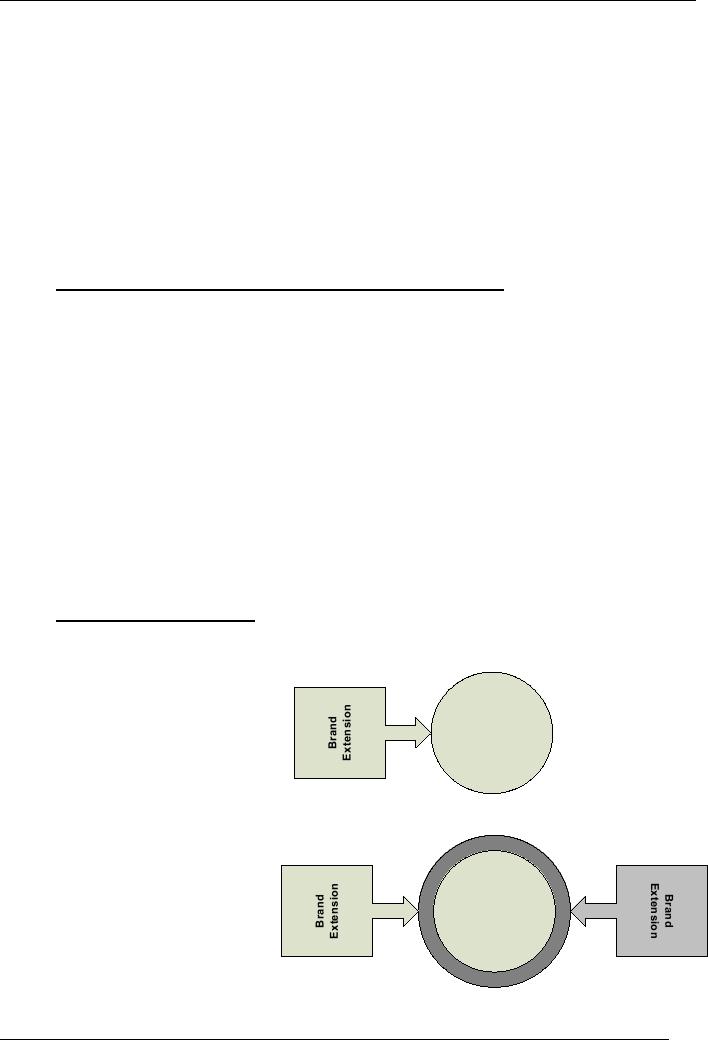 |

Brand
Management (MKT624)
VU
Lesson
23
BRAND
EXTENSION/ DIVERSIFICATION
Introduction
The
discussion on line extension in
the previous chapter gives
rise to the next level
of
discussion
on brand extension or diversification.
The lecture tends to discuss
the positive sides
of
brand extension. With
powerful arguments and evidence, we
shall see why brand
extensions
(diversifications)
have become preference of
brand and business managers.
Brand
extension is dealing with brands
that make their place in different
fields or categories.
These
could be called a collection of
different branded products having a
common name.
Mitsubishi
and Philips have already
been cited as examples. In
the context of our local
market,
Guard
brand of products are as
diverse as oil filters and
packaged rice. Sufi brand
originally
known
for soaps has diversified
into edible oil and mineral
water. Why companies prefer to go
across
categories using their established
brand names is an interesting exercise to
carry and
educate
ourselves about!
Why
extend/diversify the brand
1.
Remaining modern and up to
date
It
has become necessary. Branding is
the name of the game in
which brands try to
surpass
themselves and consumers' tastes and
expectations by being responsive.
Cars,
electronics,
and many food items are
perfect examples of tangible
products, while
banking
and courier services are convincing
service areas in which services
have been
rationally
defined and delivered, on daily
basis, to consumers as products of
ever-
increasing
standards.
Brands
that try to stick to a
single product relying on
communication alone to update
their
image do not do well. To stay
modern and responsive in present day's
world,
brands
have to stay in tune with
developments in consumers' habits and
practices1.
As
habits
change, brands also change. A salt brand
extends into an iodized
offering; a spice
brand
offers a curry recipe, while a
yogurt brand extends by
offering hi-calcium
yogurt
for
kids and young ones. Brands
respond out of the energy
they muster from the
market.
They
pay back to the market by
trying to
Rate
of Success
fulfill
emerging needs.
New
Brands vs. Brand
Extensions
If
companies do not get into
such
practices,
they run the risk of
being left
Figure
27
behind.
Possible set back in one area
can
100
be
compensated by prompt developments
in
another. So, the resourceful
companies
Br
an
dE
do
follow this practice.
xte
ns
i
on
2.
Higher chances of
success
Brand
extensions, owing to
high
50
awareness
of established brand names
and
other related factors, have
higher
30
chances
of success at lower costs.
This
has
been confirmed through a
study by
OC&C
consulting firm in 19902.
0
Retailers
are more receptive to
an
Y1
Y2
Y3
Y4
Y5
existing
brand and offer space
more
Source:
Brand Management by Jean-Noel
Kapferer
88

Brand
Management (MKT624)
VU
readily
to extensions
Impact
of Brand Extension
on
the
than
to new brands.
Consumer
Adoption Process
They
always suspect
new
brands.
Secondly,
it also has
an
impact on the
consumers,
who
through
another
analysis
by the same
consulting
firm have
Conversion
rate
Repeat
purchase
Rate
of trial
demonstrated:
�
Higher
rate of
(Index)
(Index)
New
Brand
trying
known
Figure
28
brands.
Brand
Extension
�
Higher
rate of
converting
to
Source:
Brand Management by Jean-Noel
Kapferer
known
brands.
�
Higher
rate of developing loyalty for
known brands.
The
two factors of retailers' and
consumers' patronage generate a higher
level of trial,
conversion
and loyalty3.
3.
Cost of advertising
Supporting
a family of different brands through
advertising is very
expensive.
Companies
seem to be putting an end to the
practice of introducing new brands
every
time
they introduce a new
product. Knowing that the
modern business practices and
the
brand
logic are based on
competition, it must be the
objective of every company to
save
costs.
Working
all the time to look
for a new point of
difference and surpassing their
own
benchmarks,
companies have to invest and reinvest. To
recover costs, volumes have
to
be
increased (regardless of which category
you are in) to achieve
high productivity and
economies
of scale. Costs, therefore, have to be
cut wherever and whenever
possible.
Cost-cutting
is possible in the area of advertising by
selecting a few branded
products
bearing
the same name to give
mileage to all in various
categories.
4.
Defends a brand at risk in
its basic market
There
are situations in competitive
environment where an established branded
product
starts
facing serious threats due either
to:
�
Stiff
competition, or
�
Shrinking
category as a whole, or
�
The
need to catch up with new
technologies
The
best course of action for
brand managers is to develop
something new on the
basis
of
brand awareness, loyalty,
quality image, and also sympathy. As an
example, a
bicycle
manufacturer may get into
the market of motorbikes due to one or
a
combination
of the above factors. Sohrab brand of
bicycles and motorbikes is a case
in
point.
5.
Defines new segments
It
helps define new segments.
This may sound like
remaining in the same
market. But
the
fact is if a manufacturer of safety
matches decides to get into the
area of disposable
89

Brand
Management (MKT624)
VU
lighters,
the manufacturer is venturing
into an industry that is
totally different
from
match
making. What is common is
the target market that
cuts across two
industries
(match
lights and lighter lights) and hence
leads to creating two
segments of the same
market
of "lights".
In
actuality, it is a function of so many
diverse efforts like making
investment into the
new
plant and creating an appeal
for a sub-segment of smokers from within
the overall
segment
of users of lights. While it is
extension of an existing brand
into a new
industry,
it also is an effort to define new
segments within a
market.
The
need to do so may arise due to one of
the factors discussed under
the preceding
point,
that is, stiff competition
or shrinking category of match
lights.
Brand
extension, therefore, also has
the ability to draw fine
lines within the
segments
and
define those by taking the
lead.
6.
Brand extension gives access
to an accumulated image capital
Part
of the high prices negotiated
during takeovers of companies with
established
brands
is the intention of the
acquirer to extend the brand
immediately after the
take
over,
extend it and reap the
profits from the image
capital of the brand. That
is why
many
companies internationally are known as
good acquisition targets because
they
have
established brands.
Some
brands have such a high
awareness that those are
perceived by customers to be in
categories
where they are not present.
As an example, a famous maker of
jams may be
perceived
to be in the market of chutneys and
pickles. Realizing such a
perception on
part
of the consumers, companies feel
obliged to get into those categories.
Situations
that
drive brand extension make it
mandatory for the management to
capitalize on those.
Such
situations reinforce the
accumulated brand image. It is an
interesting phenomenon;
on
the one hand it motivates
managers to acquire from the
image capital of the
acquired
brand
and on the other it lets
extensions add to the
cumulative image. The
graphics
further
illustrate the
concept.
Accumulated
Image Capital
7.
Essential for brand
survival
Brand
extension
It
is absolutely essential to
Figure
29
having
access to
break
away from the
mono
image
capital
product
in order to survive.
All
products have a life-
cycle
and are bound to
Accumulated
Image
decline
one day.
Capital
Before
a product is
subjected
to
the
implications
of the law of
obsolescence,
we must
introduce
another as a
Reinforced
Image Capital
strategic
move into a
diversified
area.
The
product
gains from the
Existing
Image Capital
brand
name and yet it is
independent
having its own
meaning.
Brand
reinforcing the
accumulated
image
capital
90

Brand
Management (MKT624)
VU
Bibliography:
1.
Jean-Noel Kapferer: "Strategic Brand
Management Creating and Sustaining
Brand
Equity
Long Term"; Kogan Page
(228)
2.
Jean-Noel Kapferer: "Strategic Brand
Management Creating and Sustaining
Brand
Equity
Long Term"; Kogan Page
(236)
3.
Jean-Noel Kapferer: "Strategic Brand
Management Creating and Sustaining
Brand
Equity
Long Term"; Kogan Page
(237)
Suggested
readings:
1.
Jean-Noel Kapferer: "Strategic Brand
Management Creating and Sustaining
Brand
Equity
Long Term"; Kogan Page
(226-231)
91
Table of Contents:
- UNDERSTANDING BRANDS – INTRODUCTION:Functions of Brand Management, Sales forecast, Brand plan
- INTRODUCTION:Brand Value and Power, Generate Profits and Build Brand Equity
- BRAND MANIFESTATIONS/ FUNDAMENTALS:Brand identity, Communication, Differentiation
- BRAND MANIFESTATIONS/ FUNDAMENTALS:Layers/levels of brands, Commitment of top management
- BRAND CHALLENGES:Consumer Revolt, Media Cost and Fragmentation, Vision
- STRATEGIC BRAND MANAGEMENT:Setting Objectives, Crafting a Strategy, The Brand Mission
- BRAND VISION:Consensus among management, Vision Statement of a Fast Food Company, Glossary of terms
- BUILDING BRAND VISION:Seek senior management’s input, Determine the financial contribution gap
- BUILDING BRAND VISION:Collect industry data and create a brand vision starter, BRAND PICTURE,
- BRAND PICTURE:Brand Value Pyramid, Importance of being at pinnacle, From pinnacle to bottom
- BRAND PERSONA:Need-based segmentation research, Personality traits through research
- BRAND CONTRACT:The need to stay contemporary, Summary
- BRAND CONTRACT:How to create a brand contract?, Brand contract principles, Understand customers’ perspective
- BRAND CONTRACT:Translate into standards, Fulfill Good Promises, Uncover Bad Promises
- BRAND BASED CUSTOMER MODEL:Identify your competitors, Compare your brand with competition
- BRAND BASED CUSTOMER MODEL:POSITIONING, Product era, Image Era, An important factor
- POSITIONING:Strong Positioning, Understanding of components through an example
- POSITIONING:Clarity about target market, Clarity about point of difference
- POSITIONING – GUIDING PRINCIPLES:Uniqueness, Credibility, Fit
- POSITIONING – GUIDING PRINCIPLES:Communicating the actual positioning, Evaluation criteria, Coining the message
- BRAND EXTENSION:Leveraging, Leveraging, Line Extension in detail, Positive side of line extension
- LINE EXTENSION:Reaction to negative side of extensions, Immediate actions for better managing line extensions
- BRAND EXTENSION/ DIVERSIFICATION:Why extend/diversify the brand,
- POSITIONING – THE BASE OF EXTENSION:Extending your target market, Consistency with brand vision
- DEVELOPING THE MODEL OF BRAND EXTENSION:Limitations, Multi-brand portfolio, The question of portfolio size
- BRAND PORTFOLIO:Segment variance, Constraints, Developing the model – multi-brand portfolio
- BRAND ARCHITECTURE:Branding strategies, Drawbacks of the product brand strategy, The umbrella brand strategy
- BRAND ARCHITECTURE:Source brand strategy, Endorsing brand strategy, What strategy to choose?
- CHANNELS OF DISTRIBUTION:Components of channel performance, Value thru product benefits
- CREATING VALUE:Value thru cost-efficiency, Members’ relationship with brand, Power defined
- CO BRANDING:Bundling, Forms of communications, Advertising and Promotions
- CUSTOMER RESPONSE HIERARCHY:Brand-based strategy, Methods of appropriations
- ADVERTISING:Developing advertising, Major responsibilities
- ADVERTISING:Message Frequency and Customer Awareness, Message Reinforcement
- SALES PROMOTIONS:Involvement of sales staff, Effects of promotions, Duration should be short
- OTHER COMMUNICATION TOOLS:Public relations, Event marketing, Foundations of one-to-one relationship
- PRICING:Strong umbrella lets you charge premium, Factors that drive loyalty
- PRICING:Market-based pricing, Cost-based pricing
- RETURN ON BRAND INVESTMENT – ROBI:Brand dynamics, On the relevance dimension
- BRAND DYNAMICS:On the dimension of knowledge, The importance of measures
- BRAND – BASED ORGANIZATION:Benefits, Not just marketing but whole culture, Tools to effective communication
- SERVICE BRANDS:The difference, Hard side of service selling, Solutions
- BRAND PLANNING:Corporate strategy and brands, Brand chartering, Brand planning process
- BRAND PLANNING PROCESS:Driver for change (continued), Brand analysis
- BRAND PLAN:Objectives, Need, Source of volume, Media strategy, Management strategy